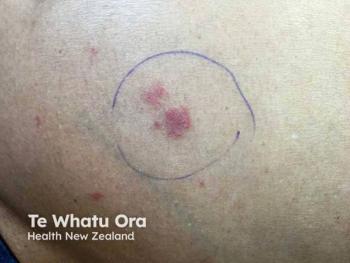
Utilizing Guidelines to Navigate Patient Education, Comorbidities, and Treatment Options
Michael Cameron, MD, identifies comorbidities, lifestyle factors, and educational opportunities AAD guidelines provide insight on for patients with atopic dermatitis.
Episodes in this series

This news content has been independently developed and is not endorsed by the American Academy of Dermatology.
This Dermatology Times Expert Perspectives series delves into the multifaceted landscape of atopic dermatitis (AD) care and treatment. Through interviews with 4 leading dermatologists, this series explores key benchmarks, emerging trends, personalized medicine approaches, long-term safety considerations, and the integration of novel therapies in the management of AD. Each episode provides valuable insights into navigating the heterogeneity of AD presentations, selecting appropriate treatment plans tailored to individual patient needs, and incorporating the latest guidelines from the American Academy of Dermatology (AAD). From discussing the nuances of patient education and shared decision-making to addressing the intersection of comorbidities with AD management, this series equips dermatology clinicians with the knowledge and strategies necessary to optimize patient outcomes and enhance the quality of care.
In this episode, Michael Cameron, MD, dermatologist at Cameron Dermatology PLLC and assistant clinical professor at Mount Sinai in New York, New York, identifies comorbidities, lifestyle factors, and educational opportunities AAD guidelines provide insight on for patients with AD.
Dermatology Times Interview with Michael Cameron, MD
Dermatology Times: The guidelines often emphasize a personalized approach to atopic dermatitis treatment. How do you tailor your treatment plans based on individual patient factors, and are there any nuances in the guidelines that guide you to make these personalized decisions?
Cameron: I try to make my care highly personalized. I love, for example, the use of JAK inhibitors and so I'm trying to use those as often as I can for people that don't want to use an injection or don't want to want to be on an oral therapy or don't completely respond to something like a dupilumab (Dupixent) or tralokinumab (Adbry). So for those kinds of patients, I personalize in the sense that I'm trying to educate them in a fair and balanced way on the tofacitinib safety data and kind of screening them for are they an appropriate patient for a JAK inhibitor like upadacitinib (Rinvoq) or abrocitinib (Cibinqo), and so that's really how I personalize it. The from a systemic perspective. From a topical perspective, topical ruxolitinib (Opzelura) cream as an elegant cream vehicle with very rapid anti-inflammatory effect is really the superior topical option at this point in terms of what's commercially available for topical AD. And so, tacrolimus ointment is greasy. I don't find pimecrolimus cream to be that efficacious. And so, it while I appreciate that the guidelines list out all these options, putting aside access to branded medications if you can get them, these brand new medications, and I think that ruxolitinib has gotten better and better access lately, I think that's really the best therapy for my patients.
Dermatology Times: In the context of emerging therapies and advancements, how do you feel the updated guidelines address novel treatment modalities for atopic dermatitis, and are there any specific recommendations or considerations for integrating those new therapies into the existing treatment landscape?
Cameron: I was happy to see the guidelines were updated for the JAK inhibitors and it approached in a fair and balanced way. I would I would disagree a little bit with the the contextualization and the background where they say upadacitinib 15 milligrams is similar comparative to dupilumab. In my view, upadacitinib 15 milligrams outperforms dupilumab, and it's not even close, anecdotally, and I write a lot of upadacitinib. I don't have the data to support that and hopefully soon we will have that head-to-head data, which will support what I'm saying. So I understand why they said that based on the available data, but when you look, and obviously cross study comparisons difficult, but I think it seems pretty obvious to me that upadacitinib, even at the low dose 15 milligrams, outperforms dupilumab.
Dermatology Times: Patient education and shared decision-making are crucial components of effective dermatologic care. How do the latest guidelines emphasize the importance of patient communication and involvement in treatment options and decision-making?
Cameron: I think the patient communication with AD is absolutely critical. You know, setting the understanding early and often with the patients that we, unfortunately at this point, do not have a cure for this disease. It's a chronic, relapsing, remitting disease that's multifactorial, whether it's skin care, whether there's stress or genetic involvement, and so the communication outside is absolutely crucial for these patients. Not only so they understand their disease, but also so they're compliant with therapies. I think the guidelines do a great job of kind of highlighting the need for that good communication.
Dermatology Times: The guidelines also touch upon the management of comorbidities associated with atopic dermatitis. Can you discuss how these guidelines address comprehensive care of patients?
Cameron: When it comes to keeping in mind these comorbidities [ask these questions]. When you're considering some of these therapies, what is the evidence behind this? What referring providers or other specialties are getting involved? What kind of screening for these comorbidities do you need to do, not only for our legacy systemic options, but also for our newer systemic therapies like JAK inhibitors? Then also [considering] the background risk for comorbidities, we know there are some comorbidities that are increasing in the AD population. So I personally, in my care of AD patients, try to always ask them in the guidelines [questions] such as, "How's your sleep? Is there any depression or anxiety and things like that?" and then also screening for these comorbidities. You know, if I'm going to use the JAK inhibitor, are you, [the patient], an active smoker? That is the most important question, from my perspective, for my many patients on JAK inhibitors. I think the guidelines do a really good job of making sure you treat the whole patient, not just their eczema.
Transcript edited for clarity
Newsletter
Like what you’re reading? Subscribe to Dermatology Times for weekly updates on therapies, innovations, and real-world practice tips.























